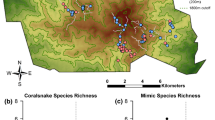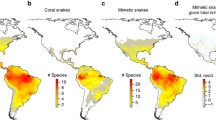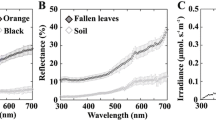Abstract
The occurrence of coral snake coloration among unrelated venomous and non-venomous New World snake species has often been explained in terms of warning coloration and mimicry. The idea that snake predators would avoid coral snakes in nature seems widely established and is postulated in many discussions on coral snake mimicry. However, the few workers that have tested a potential aposematic function of the conspicuous colour pattern focused exclusively on behaviour of snake predators towards coloured abstract models. Here we report on behaviour of temporarily caged, wild coatis (Nasua narica) when confronted with co-occurring live snakes, among which were two species of venomous coral snakes. Five different types of responses have been observed, ranging from avoidance to predation, yet none of the coatis avoided either of the two coral snake species or other species resembling these. As in earlier studies coatis appeared to avoid coral snake models, our findings show that results from studies with abstract snake models cannot unconditionally serve as evidence for an aposematic function of coral snake coloration.
Similar content being viewed by others
References
Brodie ED III (1993) Differential avoidance of coral snake banded patterns by free-ranging avian predators in Costa Rica. Evolution 47:227–235
Brodie ED III, Janzen FJ (1995) Experimental studies of coral snake mimicry: generalized avoidance of ringed snake patterns by free-ranging avian predators. Funct Ecol 9:186–190
Ernst CH (1992) Venomous reptiles of North America: Smithsonian Institution Press, Washington
Gehlbach FR (1972) Coral snake mimicry reconsidered: the strategy of self-mimicry. Forma Funct 5:311–320
Greene HW, McDiarmid RW (1981) Coral snake mimicry: does it occur? Science 213:1207–1212
Keeton WT, Gould JL (1993) Biological science. Norton, New York
Pough FH (1988) Mimicry and related phenomena. In: Gans C, Huey RB (eds) Biology of the Reptilia, vol 16. Liss, New York, pp 153–234
Savage JM, Slowinski JB (1992) The coloration of the venomous coral snakes (family Elapidae) and their mimics (families Aniliidae and Colubridae). Biol J Linn Soc 45:235–254
Smith SM (1975) Innate recognition of coral snake pattern by a possible avian predator. Science 187:759–760
Smith SM (1977) Coral-snake pattern recognition and stimulus generalisation by naive great kiskadees (Aves: Tyrannidae). Nature 265:535–536
Smythe N (1970) The adaptive value of the social organization of the coati (Nasua narica).J Mamm 51:818–820
Author information
Authors and Affiliations
Rights and permissions
About this article
Cite this article
Beckers, G.J.L., Leenders, T.A.A.M. & Strijbosch, H. Coral snake mimicry: live snakes not avoided by a mammalian predator. Oecologia 106, 461–463 (1996). https://doi.org/10.1007/BF00329702
Received:
Accepted:
Issue Date:
DOI: https://doi.org/10.1007/BF00329702




